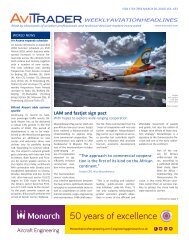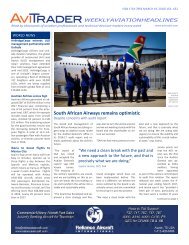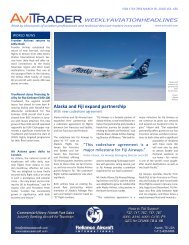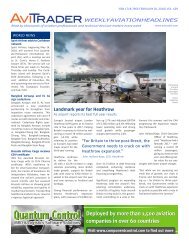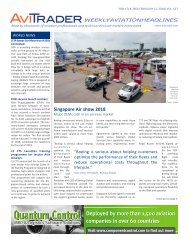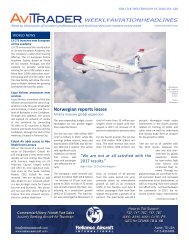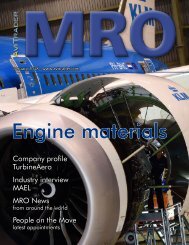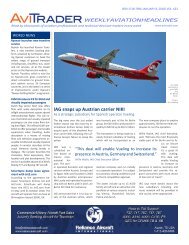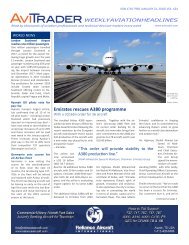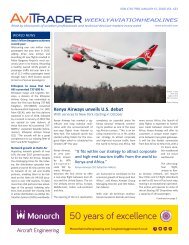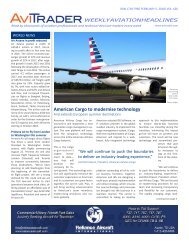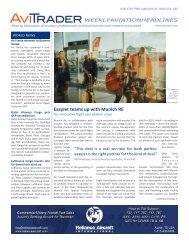AviTrader_Monthly_MRO_e-Magazine_2016-03
AviTrader_Monthly_MRO_e-Magazine_2016-03
AviTrader_Monthly_MRO_e-Magazine_2016-03
Create successful ePaper yourself
Turn your PDF publications into a flip-book with our unique Google optimized e-Paper software.
Industry Interview<br />
27<br />
In the hot seat.....<br />
Keith Mwanalushi talks large engine <strong>MRO</strong> with Roberto Furlan, VP Engineering Engine Services at SR Technics.<br />
<strong>AviTrader</strong> <strong>MRO</strong>: In terms of overhaul capacity<br />
for new and upcoming large engines, what<br />
investment or preparations have you made to<br />
meet future demand?<br />
Furlan: The priority for our engine business is<br />
to optimise turnaround times and to control<br />
the repair window. In order to achieve this, we<br />
are continuously improving our in-house repair<br />
capabilities. For instance, our shareholder<br />
Mubadala Development Company recently<br />
signed major contracts with both GE (GEnx) and<br />
Rolls-Royce (TRENT XWB) for the maintenance<br />
and repair of their respective large engines, and<br />
SR Technics will use its long-standing know-how<br />
to support the introduction of repair capabilities<br />
for both engine types.<br />
<strong>AviTrader</strong> <strong>MRO</strong>: New engine types entering<br />
service will see advances in parts repair technologies<br />
- Do you think we will see engine<br />
parts repair requirements and methodologies<br />
differ from previous engine generations? And<br />
if so, how?<br />
Furlan: We believe there will be major changes<br />
in the repair processes in the future. That is not<br />
only because composite parts like fan blades<br />
and fan cases will be used extensively, but also<br />
because new designs such as blisks (bladed rotors)<br />
and other new materials such as titanium<br />
aluminides will be utilised on a greater scale.<br />
These changes in material and design will require<br />
new advanced repair technologies.<br />
<strong>AviTrader</strong> <strong>MRO</strong>: The Asia-Pacific region draws<br />
much of the capability for large engine maintenance<br />
but labour costs have steadily increased.<br />
In your opinion what influence will this region<br />
have on engine work in the year ahead?<br />
Furlan: Costs have indeed risen in the Asia-<br />
Pacific region, and we expect this to continue.<br />
Nevertheless, what is already known today is<br />
that the number of airlines and airplanes operating<br />
in this region are set to increase, which<br />
indicates growing demand for <strong>MRO</strong> services accordingly.<br />
In response, OEMs are likely to seek<br />
to control and provide <strong>MRO</strong> services locally.<br />
We are also growing our business in Asia. SR<br />
Technics has gained a competitive edge in the<br />
region by having a local facility for component<br />
repair in Kuala Lumpur, Malaysia in order to be<br />
close to the customers.<br />
<strong>AviTrader</strong> <strong>MRO</strong>: Currently, which large engine<br />
types are you seeing the best demand for <strong>MRO</strong><br />
services, and are you seeing any new trends<br />
with airlines in terms of large engine maintenance<br />
strategies?<br />
Roberto Furlan, VP Engineering Engine Services SR Technics.<br />
Furlan: The OEMs will offer flight-hour agreements,<br />
sign JV’s or establish a network of OEMcontrolled<br />
shops. In addition, more and more<br />
leasing companies will influence the <strong>MRO</strong> business<br />
by using only OEM solutions. Also airlines<br />
will look more for flight hour agreement models<br />
and leasing offers.<br />
PW4000 turbofan on inspection.<br />
Photo: SR Technics<br />
<strong>AviTrader</strong> <strong>MRO</strong> - March <strong>2016</strong>





